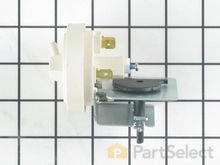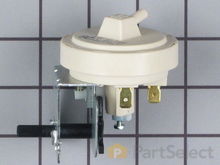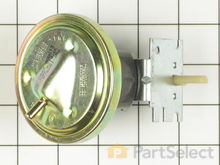Appliance Parts
- Accessories
- Dishwasher
- Dryer
- Stove / Oven
- Microwave
- Refrigerator
- Washer
- See more... See less...
Lawn Equipment Parts
- Lawn Mower
- Chainsaw
- Blower
- Generator
- Air Compressor
- Lawn Tractor
- Pressure Washer
- See more... See less...
How to Fix A Leaking Washer

Click a Part Below to Start Your Repair:
Hoses Pump Tub Cover Gasket Water Inlet Valve Bellows Or Door Boot Seal Water Level Switch Or Pressure Switch & Air Dome Tube Door Catch Tub Seal Or Boot SealAbout this repair:
- Rated as EASY
- 3010 repair stories
- 12 step by step videos
Hoses
If your washer is leaking you should first check the hoses. There are several types of hoses found on a washing machine and the most common are the drain and fill hoses.
How to inspect the hoses on your washing machine:
- Begin by inspecting the connections at the back of the washer to ensure they are tightly secured, and then verify that the leak is not being caused by a restricted house drain backing up through the standpipe.
- If no signs of leaks are found from inspecting the external hoses, disconnect your washer from the power source and remove the cabinet of your washing machine to inspect the internal hoses.
- There are many internal hoses, most will be found connected to the tub. Inspect the hoses for any signs of cracking, abrasions, or other damage.
- If you find a damaged hose(s), you will need a replacement hose(s).
Pump
The water pump or drain pump is the part on a washing machine that drains the water from the tub. The pump can be either belt driven, direct drive, or may be a separate electric pump.
How to inspect your washing machine’s pump:
- Disconnect your washing machine from the power source before beginning.
- Remove the front panel or cabinet of your appliance and locate your pump(s).
- The pump will have an outlet or drain hose, an inlet from the tub and may have a circulating hose outlet as well. If you have water leaking from the washer during a wash or drain cycle, check the area of the drain pump. Look for signs of a loose hose clamp or a leaking hose connected to the pump first.
- If the leak is originating from the pump, you will need a replacement pump.
Tub Cover Gasket
The tub cover gasket on top load and front load washers is used to provide a seal between the outer tub and the tub cover. If you are experiencing a water leak during the wash or spin portions of the cycle, then the tub cover gasket may be the problem.
How to inspect the tub cover gasket on a washing machine:
- Unplug your washing machine and remove the front panel or cabinet.
- Locate the tub cover gasket. You likely will need to remove the tub cover to access it.
- Inspect the gasket for any signs of wear or damage, you should also be looking for signs of water leaking or soapy water stains in this area to help diagnose the problem.
- If your gasket is worn, damaged, or you find signs of leaking in the area, you will need a replacement tub cover gasket.
Water Inlet Valve
The water inlet valve on your washing machine controls the entry of hot and cold water into your washing machine.
How to inspect the water inlet valve of your washing machine:
- Disconnect the power source and the water source from your washing machine before beginning.
- Remove the rear panel of your appliance and locate the water inlet valve. It likely will be located directly behind the hose connections.
- After removing the valve from the washer, inspect the screens inside the valve for any buildups or debris, removing anything you find. Use caution when doing so as the screens cannot be replaced and if they become damaged you will need to replace the entire valve. You should also inspect the valve for any signs of cracking, wear, or damage.
- Using a multi-meter on Rx1 mode, place the probes onto the valve’s terminals. The reading you should receive varies from model to model, refer to your owner’s manual for what the reading for a functioning valve should be.
- If you receive a reading outside the recommended range, if you receive a reading of infinity, or if your valve is visibly damaged, you will need a replacement water inlet valve.
Bellows Or Door Boot Seal
The door bellows or door boot seal is used on front load washers to seal between the door and the outer tub. Normal wear and tear can cause the rubber bellows to crack, and foreign objects may tear or rip the bellows and create a leak at the front of the washer. If your washer appears to be leaking near the door area, then you should suspect that the bellows may be the cause.
How to inspect the bellows on a washing machine:
- Disconnect your washer from the power source.
- Open the door and carefully inspect the bellows for signs of damage or for dirt and detergent buildup that may prevent a tight seal to the door. Use caution as sharp foreign objects that can cause tears, are often left in the folds of the bellows and may present a hazard.
- If you find any of the symptoms above, you will need replacement bellows.
Water Level Switch Or Pressure Switch & Air Dome Tube
If your washer is leaking during the fill portion of the cycle, it may be overfilling. The water level switch is a pressure activated switch that is used to determine the correct water level in the tub. As the water fills in the tub it will compress the air in the tube and push against a diaphragm inside the switch. The switch will control the water inlet valve and turn the valve off at the correct water level.
How to inspect the water level switch on your washing machine:
- Before beginning, ensure that you have disconnected the power from your washer as you will be handling electrical components.
- Locate and remove your water level switch. It is normally found behind the control panel and will have a hose or air dome tube that connects it to the tub. On washers that use an electronic control, this switch may be located at the sump area below the tub.
- To determine if the switch is bad, you should first eliminate the air dome hose as a problem. Look for signs of cracks or worn areas on the hose. Remove the hose and submerge it in water. Seal one end and blow air into the other end and look for bubbles. You should check for an obstruction in the hose as well.
- . If the air dome hose appears to be ok, then you may need a replacement water level switch.
Door Catch
The door catch on a front load washing machine is responsible for keeping the door closed tightly during the cycle. The door locking mechanism will engage the door catch or hook and prevent the door from being opened during the cycle. If the door catch is worn it may allow the door to be locked but still not provide a watertight seal.
How to inspect a washing machine’s door catch:
- Depending on your model, you may need to remove the front panel in order to access the door catch well enough to inspect it. In others, you will be able to access it by simply removing the screws holding it in place. If you must remove the front panel to access it, unplug the appliance before beginning.
- Visually inspect the door catch to see if it is cracked, discolored, worn, damaged, or if there are any foreign objects that may be preventing the door from properly closing.
- If you find any signs of wear or damage, you will need a replacement door catch.
Tub Seal Or Boot Seal
The tub seal on a washing machine is used to keep water from leaking where the transmission shaft or basket shaft enters the tub. Defective seals often start out as a small water leak but can eventually cause a failure of the main tub bearing. If your washing machine is leaking during the fill or agitation portion of the cycle, then it is possible that the tub seal is damaged and will need to be replaced.
How to inspect the tub seal on a washing machine:
- To verify whether the tub seal is causing your leak, remove the front panel of your washing machine and allow the washer to fill with water normally. Watch the area where the transmission shaft enters the tub for signs of a water leak.
- On front load washers, removal of the rear access panel is required. Look for signs of water leaking from the weep holes located near the rear bearing housing.
- If you see any signs of leaking while performing the above checks, you will need a replacement tub seal.
More Repair Parts
Still not sure which part is broken? We can offer you custom troubleshooting help if you search with your model number.











































